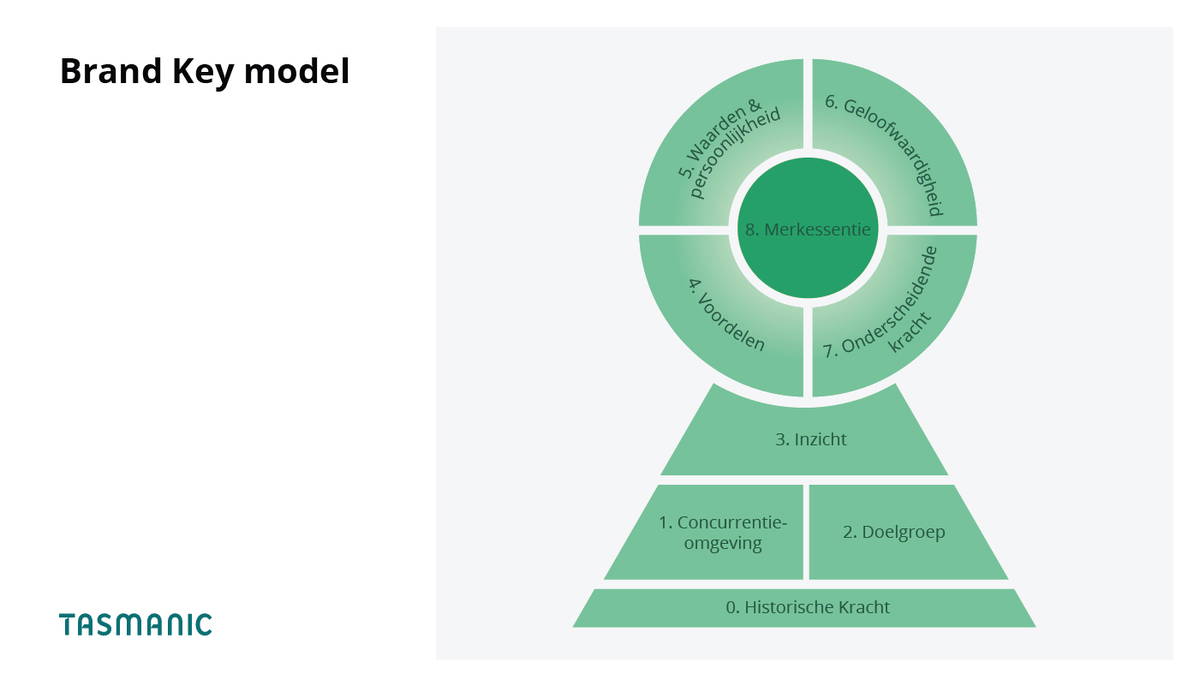
Introduction
The brand key model is a marketing model that companies use to position their brand. In the model, you take 9 steps from which your positioning follows. In this blog post, we'll tell you about the background of the brand key model and explain all 9 steps for determining positioning for your brand.
What is the Brand Key Model?
The origin of the Brand Key model is not entirely clear, and there are also several variants of this positioning tool. The best known variant is the Brand Key model developed by Unilever. This version is described in the book Positioning - Roadmap for Sharp Positioning by Rik J. Riezebos and Jaap van der Grinten. In it, the model is depicted as a keyhole which explains the name of the model.

The Brand Key Model is a strategic framework that helps companies define their brand positioning and brand strategy. The model consists of 9 key components that make up the core of the brand. These components are:
- Historical strength
- Competitive environment
- Target
- Insight
- Advantages
- Values and personality
- Credibility
- Distinctive strength
- Brand essence
You go through the model in order from steps 1 through 9. Each step forms a key, also called a Brand Key, to the positioning of your brand.
The Brand Key Model takes an outside in approach. This means it first looks from the perspective of the brand's target audience. After this, the internal factors of your brand are addressed.
The 9 Brand Keys
In this framework, you take the following 9 steps in order.
1. Historical strength
Historical strength, also called root strength, refers to the foundation of the brand: where did the brand come from, what are its core values and what is the brand historically good at? It is about understanding the fundamentals and what your brand is built on. This component helps maintain the brand's authenticity and credibility.
2. Competitive environment
Understanding the competitive environment is the next step for positioning your brand. You analyze the market, competitors and trends that affect the brand. The goal is to determine how your brand can stand out in a competitive market and what unique value it offers over competitors. Read how to conduct a comprehensive analysis in our competitive analysis knowledge article.
3. Target
The target audience is the specific group of consumers your brand targets. It is important to have a clear picture of the demographic, psychographic and behavioral characteristics of your target audience. We also recommend putting together buyer personas for your brand. This helps develop targeted marketing strategies and build a strong relationship with consumers.
4. Insight
Insight, consumer insights, is about gaining an understanding about the buying motivations and motivations of your target customers. Ask why a consumer wants to buy a product, but also why they don't want to buy a product. Also look at the latent needs and customer journey of your target customers. By responding to this and the attitudes of your target audience, you will be able to create relevant and appealing brand messages.
5. Benefits
In the fifth step, you address the benefits your products or services provide to consumers. These can include functional, emotional or self-expressive benefits. It is important to clearly communicate what benefits your brand offers and why these benefits are important to your target audience.
6. Values and personality
What does your brand stand for, what do you believe in as a company and what core values does your brand have? These elements help build an emotional connection with consumers and create a recognizable and consistent brand identity. It involves defining what the brand cares about, what it believes in and how it behaves. This includes the "Why" from Simon Sinek's Golden Circle model.
7. Credibility
As a brand, you want to be credible. Therefore, you provide arguments to your target audience that support your brand's positioning. These can be product features, certifications, testimonials or other forms of evidence that increase the credibility of the brand. The goal is to convince consumers of the reliability and quality of the brand.
8. Distinctiveness
What makes your products and services better than those of the competition? What are your unique selling points (USPs)? By having this clear, you can communicate to your target audience why they should choose your brand.
Brand essence 9.
With the insights from the previous steps, you create the core of your brand in just a few words: the brand essence. This emerges in all your expressions. For example, for Coolblue this is "everything with a smile.
Advantages and disadvantages Brand Key Model
The Brand Key model is a practical, comprehensive and structured tool that lets you look at various factors that are important to your brand. It also helps you better understand the market and competition. These are important factors for effectively positioning your brand. In addition, it is a relatively easy model to apply.
Brand Key is an outside in model. However, for brands that are culture-driven, an inside out marketing model may work better. Also, for brands that cannot easily adapt their product, an inside out may be a better fit. The MDC model is an inside out model and an alternative to the Brand Key model.
Brand Key Model template
Wil jij zelf dit model toepassen voor jouw merk? Download dan nu gratis ons brand key model template. Dit model kun je eveneens gebruiken voor je corporate branding strategie.
Are the results from your online marketing disappointing?
Request our no-obligation performance scan and we'll tell you where you're going wrong.

















 Team
Team FAQ
FAQ Vacancies
Vacancies Contac
Contac AWR
AWR Ahrefs
Ahrefs Channable
Channable ContentKing
ContentKing Leadinfo
Leadinfo Optmyzr
Optmyzr Qooqie
Qooqie Hubspo
Hubspo Semrush
Semrush




